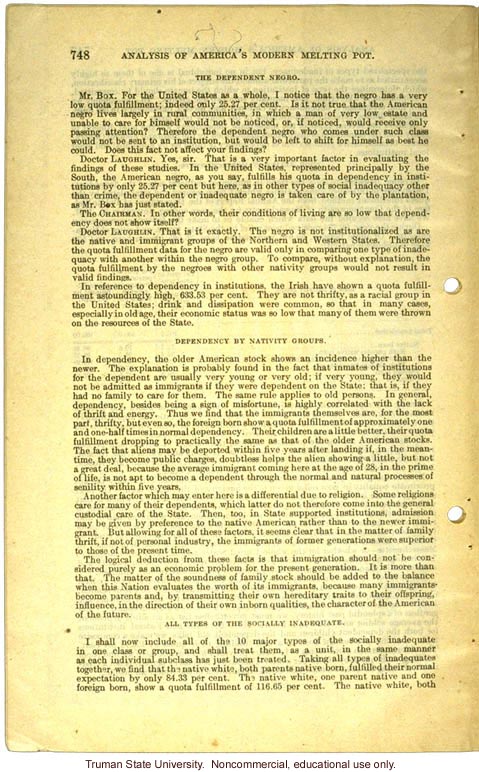748 Analysis of America's Modern Melting Pot.
The Dependent Negro.
Mr. Box. For the United States as a whole, I notice that the negro has a very low quota fulfillment ; indeed only 25.27 per cent. Is it not true that the American negro lives largely in rural communities, in a which a man of very low estate and unable to care for himself would not be noticed, or, if noticed, would receive only passing attention? Therefore the dependent negro who comes under such class would not be sent to an institution, but would be left to shift for himself as best he could. Does this fact not affect your findings?
Doctor Laughlin. Yes, sir. That is a very important factor in evaluating the findings of these studies. In the United States, represented principally by the South, the American Negro, as you may say, fulfills his quota in dependency in institutions by only 25.27 per cent but here, as in other types of social inadequacy other than crime, the dependent or inadequate negro is taken care by the plantation, as Mr. Box has just stated.
The Chairman. In other words, their conditions of living are so low that dependency does not show itself?
Doctor Laughlin. That is it exactly. The negro is not institutionalized as are the native and immigrant groups of the Northern and Western States. Therefore the quota fulfillment data for the negro are valid only in comparing one type of inadequacy with another within the negro group. To compare, without explanation, the quota fulfillment by the negroes with other nativity groups would not result in valid findings.
In reference to dependency in institutions, the Irish have shown a quota fulfillment astoundingly high, 633.53 per cent. They are not thrifty, as a racial group in the United States; drink and dissipation were common, so that in many cases, especially in old age, their economic status was so low that many of them were thrown on the resources of the State.
Dependency by Nativity Groups.
In dependency, the older American stock shows an incidence higher than the newer. The explanation is probably found in the fact that inmates of institutions for the dependent are usually very young or very old; if very young, they would not be admitted as immigrants if they were dependent on the State; that is, if they had no family to care for them. The same rule applies to old persons. In general, dependency, besides being a sign of misfortune, is highly correlated with the lack of thrift and energy. Thus we find that the immigrants themselves are, for the most part, thrifty, but even so, the foreign born show a quota fulfillment of approximately one and one-half times in normal dependency. Their children are a little better, their quota fulfillment dropping to practically the same as that of the older American stocks. The fact that aliens may be deported within five years after landing if, in the meantime, they become public charges, doubtless helps the alien showing a little, but a not a great deal, because the average immigrant coming here at the age of 28, in the prime of life, is not apt to become a dependent through the normal and natural process of senility within five years.
Another factor which may enter her is a differential due to religion. Some religions care for many of their dependents, which latter do not therefore come into the general custodial care of the State. Then, too, in State supported institutions, admission may be given by preference to the native American rather than to the newer immigrant. But allowing for all of these factors, it seems clear that in the matter of family thrift, if not of personal industry, the immigrants of former generations were superior to those of the present time.
The logical deduction from these facts is that immigration should not be considered purely as an economic problem for the present generation. It is more than that. The matter of the soundness of family stock should be added to the balance when this Nation evaluates the worth of its immigrants, because many immigrants become parents and, by transmitting their own hereditary traits to their offspring, influence, in the direction of their own inborn qualities, the character of the American of the future.
All Types of the Socially Inadequate.
I shall now include all of the 10 major types of the socially inadequate in one class or group, and shall treat them, as a unit, in the same manner as each individual subclass has just been treated. Taking all types of inadequates together, we find that the native white, both parents native born, fulfilled their normal expectation by only 84.33 per cent. The native white, one parent native and one foreign born, show a quota fulfillment of 116.65 per cent. The native white, both


